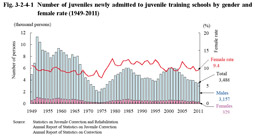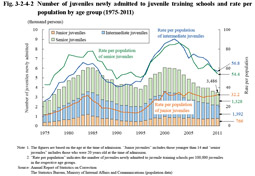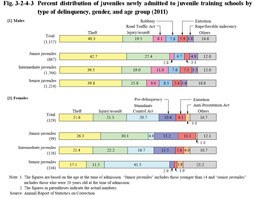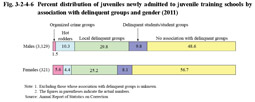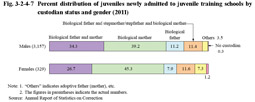Section 4 Treatment in a Juvenile Training School
1 Juveniles newly admitted to juvenile training schools
(1) Number of juveniles newly admitted to juvenile training schools
Fig. 3-2-4-1 shows the number of juveniles newly admitted to juvenile training schools by gender since 1949. The number has fluctuated after having reached a post WWII low level of 1,969 in 1974. During the last 20 years the number reached a peak of 6,052 in 2000, but then continued to decrease (See Appendix 3-12).
Fig. 3-2-4-1 Number of juveniles newly admitted to juvenile training schools by gender and female rate (1949-2011)
(2) Characteristics of juveniles newly admitted to juvenile training schools
a. Age
Fig. 3-2-4-2 shows the number of juveniles newly admitted to juvenile training schools and rate per population by age group since 1975.
The number was generally on a decreasing trend with intermediate and senior juveniles over the last 10 years, with 1,392 (down 47 from the previous year) intermediate juveniles and 1,328 (down 108 (id.)) senior juveniles in 2011. With junior juveniles, the number basically remained stable and was 766 in 2011 (up 22 from the previous year).
Comparing the rate per population of the number of juveniles of the respective age groups newly admitted to juvenile training schools in 2011 with that in 1971 (the number of juveniles newly admitted to juvenile training schools being 3,290) and then that in 1995 (3,828 (id.)), when the number of juveniles was basically at the same level as in 2011, revealed that the rate per population was higher across all age groups in 2011 (that in 1971, 1995, and 2011 of junior juveniles being 10.0, 14.9, 32.2, intermediate juveniles 32.5, 46.1, 56.8, and senior juveniles 51.0, 50.4, 54.4, respectively).
Seven juveniles younger than 14 were newly admitted to juvenile training schools in 2011 and who were all males.
Fig. 3-2-4-2 Number of juveniles newly admitted to juvenile training schools and rate per population by age group (1975-2011)
b. Type of delinquency
Fig. 3-2-4-3 shows the percent distribution of juveniles newly admitted to juvenile training schools by type of delinquency, gender, and age group in 2011. The proportion of theft and injury/assault was the highest in that order with both males and females in total of all age groups, while the proportion of Stimulants Control Act violations (20.7%) and pre-delinquency (10.6%) was higher with females than males. In addition, as the age of the group rose, the proportion of injury/assault declined with males, whereas with females that for injury/assault and pre-delinquency, etc. generally declined but that of Stimulants Control Act violations significantly rose (See Appendix 3-13).
Fig. 3-2-4-3 Percent distribution of juveniles newly admitted to juvenile training schools by type of delinquency, gender, and age group (2011)
c. Educational level and educational/employment status
Fig. 3-2-4-4 shows the percent distribution of juveniles newly admitted to juvenile training schools in 2011 by their educational level and gender, while Fig. 3-2-4-5 shows the same by their educational/employment status and gender. By educational level, the proportion of senior high school dropouts and junior high school graduates was high with both males and females. By educational/employment status, the proportion of unemployed and students/pupils was higher with females than males.
Fig. 3-2-4-4 Percent distribution of juveniles newly admitted to juvenile training schools by educational level and gender (2011)
Fig. 3-2-4-5 Percent distribution of juveniles newly admitted to juvenile training schools by educational/ employment status and gender (2011)
d. Association with delinquent groups
Fig. 3-2-4-6 shows the percent distribution of juveniles newly admitted to juvenile training schools by their association with delinquent groups and gender in 2011. The percentage of juveniles newly admitted to juvenile training schools that had associated with delinquent groups was approximately 50%, of which the proportion of those associated with local delinquent groups was the highest with both males and females. The proportion of those associating with hot rodders was higher with males than females.
Fig. 3-2-4-6 Percent distribution of juveniles newly admitted to juvenile training schools by association with delinquent groups and gender (2011)
e. Status of custodians
Fig. 3-2-4-7 shows the percent distribution of juveniles newly admitted to juvenile training schools by their custodian status and gender in 2011. The proportion of those whose custodians were their biological mothers was on a rising trend over recent years, whereas the proportion of those whose custodians included both their biological fathers and mothers was on a declining trend, and which was 15.1 points lower in 2011 than in 2002 (Source: Annual Report of Statistics on Correction).
Fig. 3-2-4-7 Percent distribution of juveniles newly admitted to juvenile training schools by custodian status and gender (2011)
